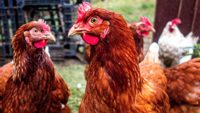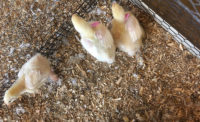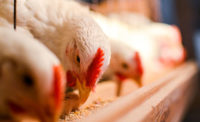Growing up on a small family-operated farm in Wisconsin, we would periodically have visitors in our barn, but for the most part the farm crew consisted of our core family of four. Either way, we had “barn clothes” that we would wear, or supply to guests, while in the barn, including old shoes, pants, shirt, and a jacket.
Being the kid I was, I didn’t realize that this was a biosecurity measure that my family had in place. Sometimes changing clothes then heading down to the barn sounded like too much work. It was far easier to head straight to the barn from the school bus, which meant that I could get chores done five minutes sooner and catch the beginning of the show I wanted to watch on TV. Now that I am better educated on how disease can spread, I realize that our farm was very fortunate not to have a devastating outbreak. Whether it would have been something that infected our laying hens, broilers, ducks, cows, or our sheep, any breakout could have sent our farm into chaos from a biosecurity breech.
With the fear of highly pathogenic avian influenza (HPAI) is in the rearview mirror of the North and in the forefront to the South, it is important to be aware of what you can do as a producer, consumer, and being an educator of HPAI in your area. Highly pathogenic avian influenza has been the topic of hot news for over the past year in my realm of poultry production. It is something that has affected every aspect of my daily routines because of dramatically increased biosecurity measures in place at our poultry farms here in North Carolina. HPAI is thought to be primarily spread by migrating waterfowl, hence its impact in the North and the current increased chance that it may hit here in the South. Scarily, there are a lot of hidden ways that HPAI could sneak into your farm without even being detected.
Biosecurity can be breeched in several ways. My adolescent laziness of heading straight from the school bus to the barn could have resulted in a biosecurity breech, as I did not know who I was in contact with that day, where my shoes had been, or if I interacted with other farm kids who may have had the same chore tactic as me. Large companies and farms that have biosecurity measures in place are well aware of the different areas of risk that are important for their farms. However, small producers may not be aware of the ways that they can improve their biosecurity without breaking the bank.
Wash your hands. This goes for both entering and exiting your barn. Although this sounds extremely elementary and straightforward, think about how many different surfaces you come into contact with in a regular day. Door knobs, car doors, a steering wheel, the shopping cart at the super market, your neighbors hand from a friendly greeting while at town, the cashier’s hand while giving change, the dollar bill you found lying on the ground, your face, your child’s seatbelt- the list is virtually endless. These surfaces potentially harbor a magnitude of diseases, and it is tough to say if the person using the shopping cart before you was in the park feeding the ducks and potentially spreading diseases to you and your farm. This is similarly true for spreading disease from your farm to others.
Designate farm use ONLY. Once again, this seems straight forward. However, think about working on the tractor and, low and behold, the part you need is in town. Yes it may be easier to hop in the farm truck, run to town in your dirty boots and farm clothes, and get the part, but how do you know if Farmer Brown down the road didn’t just do the same thing and he has an outbreak of the next disease? You might drive through the same mud he did. Walk the same aisles at the store. Maybe even shake his hand while you’re looking at feed in the back corner. It is much easier to be preventive in your biosecurity measure than needed to recover from an outbreak. If you have more than one vehicle, designate one that will stay on-farm and the other one as off-farm. If the on-farm vehicle must leave the farm, thoroughly wash the wheels and the undercarriage before leaving or re-entering the farm. Keep barn clothes separate from everyday clothes and wash them frequently. This will decrease the amount of time that a potential pathogen can be lying dormant on your clothing.
Disinfect. As an increased measure of biosecurity, adding a sanitizing foot bath outside the pen that you walk through before you enter can greatly reduce the amount of contamination you bring to the birds. This goes the same for exiting the pen. Additionally, changing these baths frequently and making sure that you actually use the sanitizing bath will increase your biosecurity.
Rodent and pest control. If you’re worried about pets encountering your bait stations, set pet-friendly traps for rodents and other pests. This is one source of disease that can be easily prevented by purchasing a few dollars’ worth of supplies. Be mindful of the fact that your own animals can bring diseases into your farm. For instance, if you are walking your dog at the park and then they help you gather eggs from the chickens in the backyard, they could have something on their feet from the park that may have just contaminated your birds.
Visitors must comply with your biosecurity measures. Say, for instance, that you have on-farm tours in your community. Supplying visitors with booties while they are on your farm, having a designated parking area, having them wear freshly laundered clothing and supplying hand sanitation or wash stations during your tours will greatly increase the chance that they will have a positive experience and that you will maintain good biosecurity at you farm. Adding gates, pathways, and other measures to keep people within certain areas while on farm can increase your biosecurity while still having positive experiences. Additionally, having a check-in area or log book and adding surveillance to know who comes on your farm can help if an outbreak does occur. If you have records, you can contact those that could have been exposed or determine who has brought the disease you your farm.
Limit cross-contamination within your farm. Seems easy doesn’t it? Say you have a sick animal and need to get chores done. In which order to you take care of them? The answer should be you take care of your healthy animals first and then the sick ones. Why? This will help keep you from spreading whatever the sick ones have to the rest of your flock. This was always the hardest thing for me to deal with because I always wanted to help the sick ones first and give them my full attention. If the sick are your priority, designate one person to work with the sick ones and another for the healthy animals.
Be mindful. This is very important, because if we think about possible ways that we may bring pathogens in or out of our farms, we can reduce the actual instances of spreading of diseases. Being mindful is something that is in society for a reason. It’s not that when we are on a plane or in a movie theater that we don’t know where the exits are located. But being reminded of the fact that, in the case of emergency it will be easier to know where to go if you have already thought of the possibilities versus having to think under pressure.
No strategies are completely foolproof, but completing any combination of the seven tactics above can help greatly reduce the possibility of getting HPAI, or any other disease, on your farm. Keeping in mind how to prevent diseases from entering or exiting your farm can increase your chances of success as an educator and a farmer.





Report Abusive Comment